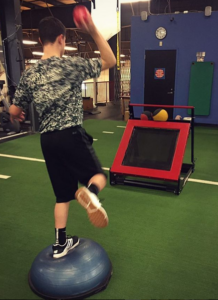Why Strong Ankles Are Your Hidden Superpower!
When you sprint, cut, jump, or lift, the first link to meet the ground is your foot and ankle. If that link is mobile, strong, and well-coordinated, power flows up the chain. If it’s stiff, weak, or wobbly, force leaks—and the risk of injury rises.
How common are ankle problems in active people?
● Ankle sprains are among the most common sports injuries across collegiate athletics, accounting for ~15% of all reported injuries. Indoor/court sports show the highest rates.
● After a first sprain, reinjury is common. Meta-analytic data in athletes report recurrence around 17% (and higher in some elite cohorts). Each sprain typically costs about two weeks of time-loss.
● Sprains aren’t just “short-term nuisances.” A large share of ankle osteoarthritis is post-traumatic, meaning it starts with injuries like sprains.
Why ankle strength + mobility matter for performance
● Limited ankle dorsiflexion (knee-over-toe motion) alters landing and squatting mechanics and can reduce efficiency in jumps and cuts—issues athletes feel as lost power or “stiff” movement.
● Restricting ankle bend during stop-jump tasks shifts loads up the chain in ways that can compromise mechanics.
● Bottom line: Better ankle motion + control = cleaner force transfer, smoother cutting, stronger lifts, and fewer “uh-oh” moments.
What the research says about PT interventions
● Exercise-based rehab lowers reinjury risk. Compared with “usual care,” structured exercise programs (strength, balance, neuromuscular training) reduce recurrent sprains after an acute injury. (Exact “best program” details vary, but the overall effect is protective.)
● Balance/neuromuscular training is a cornerstone. Systematic reviews and meta-analyses show balance/neuromuscular training
improves patient-reported function and dynamic balance in chronic ankle instability (CAI), and helps prevent sprains in active populations.
● Strength work helps—but isn’t enough alone. Isolated strength training by itself doesn’t consistently move the needle on balance or function in CAI. It’s most effective when combined with sensorimotor work.
● Taping/bracing are useful tools, but not magic. External supports can reduce inversion angles and may help some athletes, but network/meta-analytic evidence suggests they do not outperform well-designed training for dynamic control. Use them as adjuncts, especially during return-to-play, while you train the system.
● Follow clinical practice guidelines. The JOSPT Clinical Practice Guideline recommends a combination of manual therapy, progressive exercise (strength + balance), and external supports individualized to stage and sport demands.
 A quick self-screen for athletes
A quick self-screen for athletes
Try the knee-to-wall test (keep heel down, knee taps wall). Aim for ~10 cm or more without the heel lifting and with the knee tracking over the toes. If you’re limited or asymmetric, you likely benefit from mobility work and control training. (Discuss thresholds with your PT.)
A simple, evidence-informed “from-the-ground-up” routine
● 10–15 minutes, 3x/week (plus sport-specific work)
Mobility (2–3 sets)
● Ankle rockers (knee over toes, heel down), slow 10–15 reps/side.
● Calf stretch: straight-knee (gastroc) and bent-knee (soleus), 30–45s each.
Strength (2–4 sets)
● Single-leg calf raises (controlled 2–3s up/3–4s down); progress to weighted.
● Bent-knee calf raises (targets soleus; massive for runners/jumpers).
● Tibialis anterior raises (heel on floor, lift forefoot).
Balance / neuromuscular (3–5 sets of 20–40s)
● Single-leg balance → add eyes-closed, ball toss, or perturbations.
● Reach tasks (Star Excursion/Y-Balance style reaches).
● Hops: in-place pogo → single-leg line hops (focus on quiet, symmetrical landings).
Progressions for field/court athletes
● Deceleration & cut prep: drop-to-stick, lateral shuffle-to-stick, controlled 45–90° cuts.
● Layer intensity and complexity only if you can land quietly and hold positions without the ankle “diving” into inversion.
When to get evaluated
● Recurrent “rolls,” swelling after play, or that never-quite-right feeling when you cut, land, or squat.
● Morning stiffness or pain that eases with warm-up (consider tendon loading strategies).
● You fail return-to-sport tasks (single-leg hop series, cutting/landing tests) or feel unsure about readiness. Evidence-informed PT can fill those gaps.
Take-home Message
● Ankle sprains are common and recurrent—and they can snowball into chronic instability or even post-traumatic arthritis if ignored.
● The strongest data support multimodal rehab: mobility + strength with balance/neuromuscular training, tailored to your sport.
● Braces/tape can help you feel secure while you train, but training the system is what changes outcomes long-term.
How Elite Can Help!
Are you or someone in your family dealing with ankle issues? If so, the experienced team of expert Physical Therapists at Elite are here to help! To learn more about Physical Therapy at Elite, click HERE! To schedule as Initial Evaluation with one of our PTs, give us a call at 781-297-0979 (Stoughton) or 774-215-5401 (Foxboro) to schedule today!
References
Doherty, C., Delahunt, E., Caulfield, B., Hertel, J., Ryan, J., & Bleakley, C. (2014). The incidence and prevalence of ankle sprain injury: A systematic review and meta-analysis of prospective epidemiological studies. Sports Medicine, 44(1), 123–140.
https://doi.org/10.1007/s40279-013-0102-5
Flore, P., Pedret, C., Royuela, A., & Ibañez, J. (2022). Time loss and recurrence of lateral ankle sprains in athletes: A systematic review and meta-analysis. Scandinavian Journal of Medicine & Science in Sports, 32(4), 658–670. https://doi.org/10.1111/sms.14116
Wagemans, A., Oosterwijk, A. M., van der Wees, P. J., & Meijer, O. G. (2022). Effectiveness of exercise therapy for the prevention of recurrent ankle sprains: A systematic review and meta-analysis. PLOS ONE, 17(2), e0263944. https://doi.org/10.1371/journal.pone.0263944
Wang, Y., Xu, D., & Li, Y. (2021). The effect of balance training on chronic ankle instability: A systematic review and meta-analysis. Sports Health, 13(3), 242–250. https://doi.org/10.1177/1941738120965949
Martin, R. L., Davenport, T. E., Fraser, J. J., Sawdon-Bea, J., Carcia, C. R., Carroll, L. A., Hertel, J., Houck, J. R., Kaminski, T. W., Logerstedt, D. S., McKeon, P. O., Wikstrom, E. A., & Wukich, D. K. (2021). Ankle stability and movement coordination impairments: Lateral ankle ligament sprains revision 2021 clinical practice guidelines linked to the International Classification of Functioning, Disability and Health. Journal of Orthopaedic & Sports Physical Therapy, 51(4), CPG1–CPG80. https://doi.org/10.2519/jospt.2021.0302.
